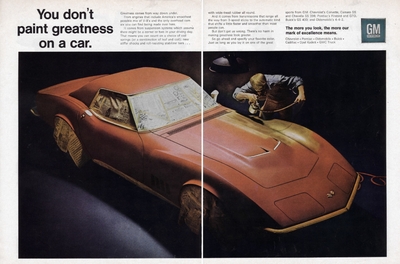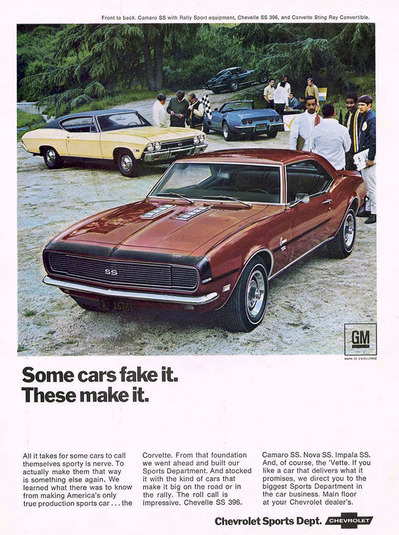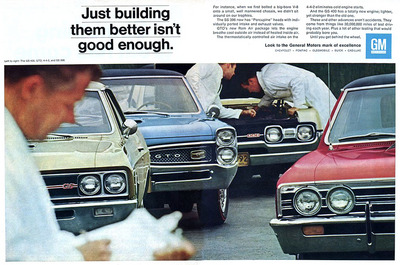Corvette History Through Ads: Multi-Divisional/Model Ads
? 7-24-2013 All rights reserved, do not duplicate without permission.
Even though the image shown is that of a 1968 Corvette, technically it’s not a pure Corvette advertisement. It is one of a group of ads that advertise cars with a common purpose from more than one division or more than one model and known as multi-divisional or multi-model ads. This type of ad first surfaced during the mid 1950’s centered around several different models of station wagons. It is a particularly effective format when a manufacturer or a division offers several different vehicles with a primary focus ? and in this ad General Motors is pitching the hottest trend of the era, performance and muscle cars. Though officially the GTO is credited with being the father of the muscle cars, clearly the Corvette paved the way for the focus on performance long before John DeLorean ever thought of what would become the GTO. Stuffing big, high horsepower engines into smaller cars was something Corvette learned back in the mid 1950’s when Zora Arkus-Duntov had GM put a V8 engine in the small sports car.
As more and more consumers demanded bigger engines and improved performance, all of the Big Three auto manufacturers were quick to respond. Even little American Motors could not resist the lure of increasing sales by building a performance based car. But what many buyers quickly learned was that some sporty looking cars were little more than paint and emblems. Auto manufacturers were not immune to using smoke and mirrors to help boost the image and improve sales of a mediocre model. Even General Motors offered paint and stripe ?appearance? packages on some of their cars for buyers who wanted the ?look? but didn’t want or need the better performing and higher priced muscle cars.
Certainly many of the muscle cars did in fact live up to their monikers, and true to their purpose offered huge horsepower, upgraded suspensions, and improved braking. It was during this period that GM offered outstanding performance engines and upgraded brakes, suspensions, and transmissions. Starting with the 396 cubic inch engine that served as the basis for most of the performance based muscle cars, with the impressive 427 also offered and culminating in the the vaunted L88 and L89 engines. Chrysler introduced their infamous Hemi engine and it was so powerful and effective that NASCAR banned it for the 1965 racing season. Chrysler stuffed their deadly engine into almost every model they produced. It was particularly effective when it was bolted into a Dodge Challenger or Hemi ?Cuda?. Ford’s 427 side oiler was a potent performer and their Boss 429 was considered by many to be the fastest of all muscle cars. Performance was so important to sales that more than one manufacturer actually understated their published horsepower ratings for some engines to avoid prohibitive insurance premiums. Suffice it to say that it was not difficult for a true enthusiast to find a new production car offering incredible performance with between 400 to 550 HP.
General Motors was clearly the leader in performance models offered to meet the needs of their customers. Several of their cars fell under the ?performance/muscle car umbrella? and one of the best ways to let the consumer know about it was to use the multi divisional ad which showed their performance/muscle car offering from each division. The concept was also an extremely cost effective method to get the word out about more than one car model. And as GM was the dominant performance leader among manufacturers, Chevrolet was the leader within GM. So they also adopted the advertising concept of showing several Chevrolet performance/muscle models in a singular advertisement.
Though no one has been able to verify whether it was GM or Chevrolet that ran the first ?multi model? performance ad, the earliest multi-model muscle ad I have been able to uncover was a General Motors 1967 advertisement ?Just building them better isn’t good enough,? which shows a Buick GS400, a Chevelle SS396, a Pontiac GTO, and an Oldsmobile 442. Early in 1968 Chevrolet ran a multi-model ad which featured their SS cars: Camaro, Nova, and Chevelle along with a new 1968 Corvette convertible, ?Some cars make it, Some cars fake it.? If you look closely you can also see a 1967 Corvette Sting Ray coupe in the background. Both GM and Chevrolet continued to use this concept through the early 1970’s after which time several cars had to ?fake it? with paint and stripes since government regulation virtually gutted the performance car. But during the ?golden years? of performance GM had no need to ?fake it?. They simply made great performance cars, the ultimate being the Corvette. Like the advertisement states,
?There’s no harm in making greatness look greater. So go ahead and specify your favorite color. Just as long as you lay it on one of the great sports from GM: Chevrolet’s Corvette, Camaro SS and Chevelle SS 396; Pontiac’s Firebird and GTO, Buick’s GS 400; and Oldsmobile’s 4-4-2.?



